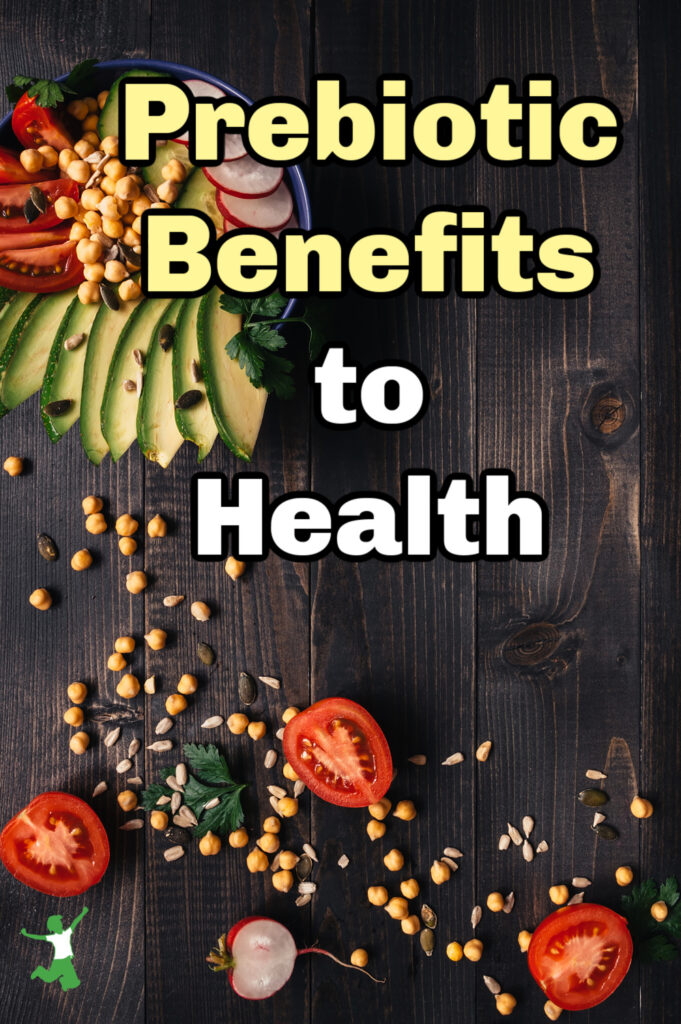How prebiotics work as functional foods hand-in-hand with probiotic flora to improve the integrity of the gut and optimization of the immune system.

The term prebiotics is a relatively new term relating to the topic of gut health. The concept first came on the scene in 1995 when beneficial food ingredients that pass undigested through the stomach and intestines were first identified.
Researchers were shocked to learn that these undigested foods actually served as nourishment for the probiotics in the gut, those beneficial microbes that perform useful biological functions and are a critical component of a healthy immune system.
According to Dhekhar K. Chalia MD, author of Probiotics for Dummies, the important properties of prebiotics, found only in plants, are threefold:
- Healthy bacteria building potential
- Starch and sugar replacement capabilities
- Improving gut health as fiber
Prebiotics Feed and Strengthen Gut Flora
In essence, prebiotics are a type of dietary fiber that encourages the growth of favorable intestinal flora. They do this by acting as functional food for these organisms.
It is important to note that prebiotics are not alive like probiotics. Prebiotics are a functional food, whereas probiotics are living organisms.
By nourishing these helpful microbes known as probiotics, a prebiotic effect occurs where there is an increase in the activity of healthy bacterial colonies such as bifidobacteria and lactobacilli. This strengthens the gut environment and provides resistance to invading pathogens thereby shoring up the immune system.
The great news is that prebiotics are heat resistant, and so, to a large extent, remain unaltered during the cooking or baking process. It also ensures that they will reach the intestines unaffected by the digestive process in order to trigger the beneficial prebiotic effect.
Top Ten Prebiotic Foods
The top ten foods that contain prebiotics are as follows.
Cooking generally does not diminish the prebiotic effect except in the case of resistant starch.
In fact, researchers report that cooking onions (caramelized in butter is best) actually slightly increases the prebiotic value. Similar foods include:
Try to incorporate as many of these foods (that you tolerate) into your dietary regime on a regular basis. Variety is highly beneficial when it comes to prebiotics!
Promise for Blood Sugar and Weight Control
A specific type of prebiotic known as resistant starch is showing much promise far and beyond gut health benefits.
Not only is it turned into energy-boosting, inflammation-squashing short-chain fatty acids by probiotic bacteria, but resistant starch is also proving helpful for stabilizing blood glucose levels, increasing insulin sensitivity, reducing appetite by increasing satiation, and encouraging weight loss that is easier to maintain.
Be wary as all forms of resistant starch are not the same, however! Note that some resistant starch is industrialized and should be avoided, the types you want are types 1-3 below.
- Type 1 – This type of resistant starch is bound by fibrous cell walls and therefore resists digestion, such as beans/ legumes, grains, and seeds.
- Type 2 – Indigestible due to its high amylase content when in its raw form, such as found in potatoes, plantains, and green bananas. Heating or over-ripening these foods renders a portion of the resistant starch no longer indigestible.
- Type 3 – This type of resistant starch is the result of a process called retrogradation- when starches are cooked and then immediately cooled, which allows the digestible starch in some foods like rice, potatoes, and beans to be more resistant to digestion.
- Type 4 – Industrialized resistant starch that does not occur in nature. It is man-made via a chemical process and should be avoided.
Prebiotic Foods to Turbocharge your Probiotic
Resistant starch as a specialized form of prebiotic can be obtained either through food or supplements. Common food sources include:
- Retrograded potatoes (cooked and then cooled)
- Green bananas (unripe)
- Plantains
- Legumes (cooked and cooled)
- Parboiled (partially cooked) rice
- Some grains such as teff (gluten-free) and wheat.
- Potato starch (healthier than potato flour)
- Plantain flour
- Green banana flour
- Cassava powder and tapioca starch
Go Slowly at First!
If the potential of using resistant starch as a prebiotic for blood sugar and weight control is appealing to you, be aware that it needs to be added slowly to your diet until your body becomes used to it.
Otherwise, you may end up experiencing painful and embarrassing episodes of gas and bloating!
Also be aware that if you are already grappling with gut imbalance issues or suffer from IBS, colitis, Crohn’s disease or other GI illnesses or infections, resistant starch should really be avoided until you are at least in partial remission.
You can try experimenting with low amounts of resistant starch to see how it goes, but be aware that it may add to the problem rather than help the situation until you are further along in your healing journey.
Prebiotics in Breast Milk
Breastfeeding is known to benefit a baby’s developing immune system, so it’s no surprise that prebiotics have been identified via research to be present in human breastmilk.
Specifically, the prebiotics known as oligosaccharides (HMOs) are highly abundant in and unique to human breastmilk.
HMOs are anti-adhesive antimicrobials that prevent pathogen attachment to infant mucosal surfaces (ear, nose, throat, gut, etc) and lower the risk for viral, bacterial, and protozoan parasite infections.
HMOs may even make your baby smarter as they provide the infant with sialic acid which shows potential as an essential nutrient for brain development and cognition!
Daily Consumption Amounts
There is currently no broad consensus on an ideal amount of prebiotics to include in the diet on a daily basis either via food or supplements.
Recommendations range from 4 – 8 grams per day for general digestive health support. Therefore, if your gut is in good shape, try a little bit at a time and increase slowly to observe how it works for you.
Those with digestive disorders may require much more (up to 15 g/.53 oz per day) to support the growth and development of healthy flora.
However, it would be wise to consult with a holistic healthcare practitioner on the best type of prebiotics to incorporate without exacerbating your particular medical condition.
Quality Brands
Another good idea is to check to see that the probiotic you take has some prebiotics included to nourish the microflora once it reaches your gut.
This is not necessary if you are eating prebiotic functional foods already.
The probiotic brands I have vetted and personally use or recommend are:
If you’d like me to take a look at your prebiotic or probiotic brand of choice, please reach out using the purple chatbox in the right-hand corner of the screen. Note: this service is for members of Healthy Home Plus.

References
(1) Human milk oligosaccharides
(2) Foods Containing Prebiotics
More Information
The Best Resistant Starch
Why Fermented Foods are Not Enough to Heal the Gut (and the probiotic boost they need)
Choosing the Best Probiotic and Prebiotic Supplement
How to Take Probiotics for Maximum Benefit








Hi Sarah,
For those supplementing with prebiotics, do you have any vetted brands you can recommend aside from food? Looks like everything on your site is probiotics or probiotics with prebiotics.
Thanks!
Sarah, do you know if you can have chicory root while breastfeeding? I’m struggling to find legitimate answers.
4 tablespoons of potato starch? Not sure this is the smartest choice. Starch is a highly processed food with poor nutritional value and a high glycemic index. It can also glue to your intestines and slow down your bowel movements.
Just make sure you consume a variety of whole fruits, veggies, legumes, grains, seeds and nuts. These are the favorite food of your probiotic bacteria.
Cheers!
I guess you’ve never heard of resistant starch? It feed probiotics in the gut, is indigestible and studies are showing it reduces belly fat. The Standard American Diet, while high in starch, is very LOW in resistant starch. Might want to read up some more as your views are not up to date.
Hello Sarah,
I think i have some Form of leaky gut so therefore i drink kefir everyday.
I usually do a second fermentation with prebiotics/RS like Onions or plátano/banana starch to give the probiotics a head start on consuming them before they arrive the small intestines in csse i have SIBO.
Does this make sense?
Does Retrograded potatoes, legumes (cooked and then cooled) mean you can cook them anyway (boiled, freed with onions, baked in the oven) and just eat them after they cool. I keep reading people who say to cook and cool but no one really explains.
Sarah,
I have been taking Garden Of Life: Primal Defense Ultra in addition to four tablespoons daily of potato starch. Do you have any opinion on Primal Defense?
do retrograded potatoes need to be consumed cold? i cook whole potatoes in a sous vide water bath at 158 degrees F for 3-4 hours. this does completely change the texture of the potato.
then i peel them, coarsely grate them and fry or add to soups/stews. am i defeating the purpose?
Sarah – do you have any thoughts on those who are unable to supplement with prebiotics? I have tried both potato starch and FOS with the result being extreme joint pain and fatigue. I do not have any symptoms of SIBO, and in fact feel pretty great. I have used a number of the probiotics you recommend for about a year and a half, in addition to a lot of fermented foods. I did some gut testing and was told that my microbiota is healthy. I love the idea of benefiting from prebiotics, but am not inclined to use them based on my experience so far.
Do others have this issue?
Thanks so much. Love your blog.
Heather
Have you tried some of the more gentle prebiotics as food, not in supplement form? I would suggest soaked teff porridge, cooked plantains, onions, garlic etc. You don’t have to supplement to get the wonderful benefits of prebiotics.
Sarah, do you have a cooked plaintain recipe or two that you could share?
Hi Beth, this recipe for banana fritters that I posted a few years back works beautifully with plantains as a substitute for the bananas. https://www.thehealthyhomeeconomist.com/to-die-for-no-grain-banana-fritters/
Thanks!
Just FYI, there’s a typo in that recipe, I think, because bananas aren’t listed (although it’s obvious you need them, it just would be helpful to know how many). Coconut oil isn’t listed in the ingredient list either. 🙂
Thanks .. will fix that recipe. From the blogging early days 🙂
Hi Sarah – Yes I eat a lot of food that qualifies as prebiotic (although I haven’t learned to love Teff yet). It sounds like some people are also supplementing pretty heavily with good results, and so I had hoped to try it. But it isn’t worth those side effects. I wonder how common the joint pain is, I really can’t find where people are having issues with anything other than potato starch. Thanks for the reply!